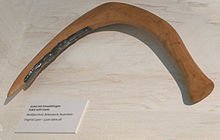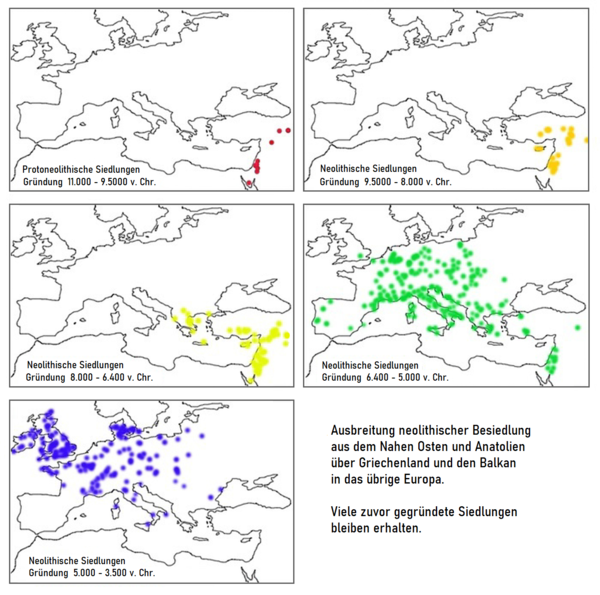Neolithic
The Neolithic or New Stone Age, technically Neolithic (from the ancient Greek νέος neos 'new, young' and λίθος lithos 'stone'), is an epoch in human history defined as the (first) transition from hunter-gatherer cultures to pastoral and farming cultures. The decisive criterion for the beginning of the Neolithic is the evidence of domesticated useful plants.
Deviating from this, the Neolithic in the sphere of influence of the former Soviet Union was and still is defined by the presence of ceramics and the absence of metals, which can lead to considerable misunderstanding, especially in quotations (e.g. from David W. Anthony, who follows this practice for the Eastern European territories), since such a definition can mean both Mesolithic and Ceramic Neolithic in international usage.
According to current knowledge, the Neolithic period first began around 9500 BC in the Fertile Crescent of the Near East (especially on the southern edges of the Zāgros and Taurus Mountains). The date of onset, however, is generally referred to the region under consideration, so that the Neolithic period did not begin until between 5800 and 4000 BC in, say, central and northwestern Europe. In at least two other areas of the world, an analogous development occurred independently of the Near East.
The transition to Neolithic agriculture (technically known as the Neolithic Revolution or Neolithization) took place differently worldwide in suitable regions (see: Ecumene) depending on the prevailing climatic and ecological conditions. The sedentarization of the wild hunter-gatherers, which had already taken place in the Proto-Neolithic, was secured against food shortages by crop cultivation. While increasingly larger, stationary village communities were formed among the farmers, the way of life of the pastoral pastoralists remained nomadic or semi-nomadic for the time being. The cultivation of fields in particular created the basis for a society based on the division of labour. Food production and stockpiling led to greater independence from uncontrollable population fluctuations of wild animals and plants. This led to a sharp increase in population growth in the neolithized regions.
The end of the Neolithic is defined in the Old World as the transition to the epochs of early metalworking. Thus, the Copper Age in Europe and the Near East is still considered the last epoch of the Stone Age, while the subsequent Bronze Age replaced the Neolithic between 3300 and 1800 BC, depending on the region. In Africa, the Neolithic was directly followed by the Iron Age. In Oceania and America, on the other hand, no or only rudimentary metalworking cultures developed until colonization by the Europeans.
Definition
In his 1865 work Prehistoric Times, the British anthropologist Sir John Lubbock divided the Stone Age into the "period of cut stone" (Old Stone Age) and the "period of polished stone", which he called the New Stone Age. Today, the beginning of the Neolithic is associated with the transition from an acquisitive (hunting, gathering, fishing) to a productive economy (agriculture, horticulture, livestock). The associated cultural change brought with it a number of other features, which are now also referred to as the 'Neolithic package':
- Sedentarism of the peasants (nomadism remains with the cultures based on livestock farming. Several mixed forms such as transhumance).
- domestication of plants and animals
- Distribution of ground stone tools (stone axes, axes)
- Expansion of the use of ceramic vessels

Reconstruction of a Neolithic sickle made of wood with glued-in flint blades
Temporal classification of the Neolithic cultures of the Near East and Europe
- 12,000 to 9500 B.C.: Proto-Neolithic (cultures: Natufia, Harifia, Sultania and Khiamia)
Some hunter-gatherer and fisher cultures that existed in the Levant and along the middle Euphrates were already largely sedentary in the Epipalaeolithic due to the fertile climate and a correspondingly large food supply in the Alleröd interstadial. From about 10,700 BC onwards, the more recent Dryas period saw a sharp drop in cold temperatures, which increasingly led to seasonal food shortages. In order not to have to give up their sedentary way of life again, wild cereals were increasingly used and a first, unregulated cereal cultivation developed. Since it is only possible to a limited extent to distinguish the harvesting of wild cereals without reseeding from deliberate cultivation, the Protoneolithic is not yet counted as part of the Neolithic. The dwelling places consisted of round huts (Mallha/Eynan). Flint tools were not yet ground, but hammered into the desired shape.
Important locations: Jericho and Mureybet I A
- 9500 to 8200 B.C.: Pre-Pottery Neolithic A (PPNA), older phase of the Aceramian period.
Evidence of domesticated cereal plants. During this period, the first settlements consisted of round houses (dry-stone masonry). Some of the settlements lie in the lowest layer of later tells. The art of this time was mainly limited to idols, small stone sculptures, which mainly depicted women, more rarely men or animals. Cereal cultivation was probably already known at this time, but did not yet form the basis of the diet. Cattle breeding cannot yet be proven osteologically at this early stage; gazelles continued to be hunted.
Important sites: Mureybet I B, II, III, Tell es-Sultan (Jericho), Göbekli Tepe III
- 8200 to 6800/6500 B.C.: Pre-Pottery Neolithic B (PPNB)
The houses were rectangular or square. The domestication of animals is established, a spread to the west took place, with raft and dugout canoe also across the sea (Cyprus). Mostly female idols made of stone or clay with only suggested faces but clearly pronounced genitals now appeared. Tool production by ground stone industry and first unfired pottery is known.
Important sites: Nevali Cori, Göbekli Tepe II, ʿAin Ghazal
- 6500 to 5500 BC: Ceramic Neolithic in the Near East (Pottery Neolithic, PN), from about 6200 BC also in the eastern Mediterranean region
Burials of the dead now took place outside the settlement. In addition to the cultivation of cereals, farm animals were also known, hunting was no longer the main source of meat. Ceramics production became more widespread. Archaeologically, the Ceramic Neolithic is divided into three phases:
· monochrome phase
· painted phase
· classic phase
The excavations at Jericho and Mureybet were carried out by Jean Cauvin, Kathleen Kenyon and John Garstang. The scientific system goes back to them.
- 5500 to 2200 BC: Neolithic period in Central Europe
The sub-stages Early Neolithic, Middle Neolithic, Late Neolithic, Final Neolithic are defined differently in individual regions. In southern Central Europe, the stages Late Neolithic, Late Neolithic and Final Neolithic are also synonymously called Copper Age (also called Copper Age for short). In some regions (e.g. Moravia, Hungary, Italy) the Neolithic is defined more narrowly and the Copper Age is called the "Aeneolithic" or "Chalcolithic".
Phase of peasant cultures: metal did not yet play a major economic role.
- 5500 to 3300 BC: Copper Age (also called Copper Age, Chalcolithic or Aeneolithic) in the Near East
Beginning of metal processing in the smelting process. Now also formed social upper classes, long-distance trade and more fortified settlements.
- 4500/4000-2200 BC: Copper Stone Age in Central Europe
In southern Central Europe a distinction is made between the Late Neolithic, Late Neolithic and Final Neolithic.
Earliest copper processing in Central Europe (Jordansmühl Culture, Lengyel Culture). Evidence of own ore mining and smelting (Mondsee group) only in the course of several centuries. Influence of western megalithic culture (e.g. Michelsberg Culture, Nordic Funnel Beaker Culture).

The spread of Neolithic cultures from the south-eastern Mediterranean to north-eastern Europe. 11,000 to 9500 B.C. (Younger Dryas Period) 9500 to 8000 BC (Preboreal to Boreal) 8000 to 6400 BC (Boreal to Atlantic) 6400 to 5000 BC (Atlantic period) 5000 to 3500 BC (Atlantic to Subboreal)

Map of the European Neolithic, c. 4500-4000 BC.
Questions and Answers
Q: What is the Neolithic period?
A: The Neolithic period is the last part of the Stone Age.
Q: What came after the Neolithic period?
A: The Bronze Age came after the Neolithic period.
Q: What did people invent during the Neolithic period?
A: People invented farming and started caring for animals, such as cows, sheep, and pigs during the Neolithic period.
Q: Why did the Neolithic period start at different times in different places?
A: The Neolithic period started at different times in different places because not everyone started farming at the same time.
Q: What does the word "Neolithic" mean?
A: The word "Neolithic" means “new Stone Age.”
Q: Where does the word "Neolithic" come from?
A: The word "Neolithic" comes from two words in Greek meaning "new" and "lithic" ("stone").
Q: What did people do during the Neolithic period?
A: During the Neolithic period, people invented farming and started caring for animals, such as cows, sheep, and pigs.
Search within the encyclopedia